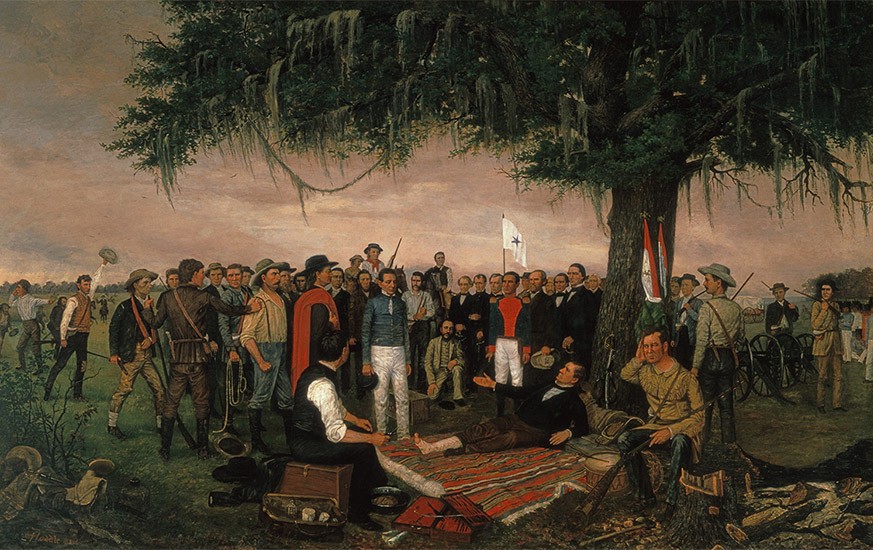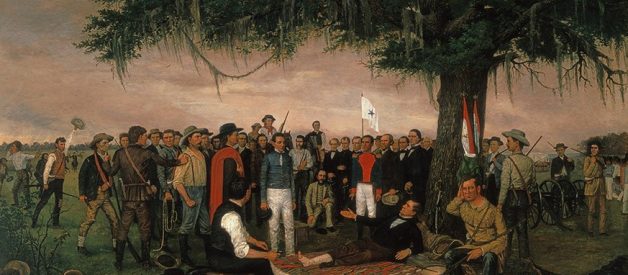On This Day in Texas History ? April 22, 1836
By: Dr. Richard Bruce Winders, Alamo Director of History and Curation
 William Henry Huddle. The Surrender of Santa Anna. Texas State Preservation Board, Capitol Historical Artifact Collection, Austin
William Henry Huddle. The Surrender of Santa Anna. Texas State Preservation Board, Capitol Historical Artifact Collection, Austin
Antonio Lpez de Santa Anna fell prisoner to the Texans on April 22, 1836. The day before, the leader of Mexico and commander of its army operating in Texas had mounted a horse and had ridden away, thereby escaping the wrath of Texans and American volunteers who sought vengeance for victims of the infamous Tornel Decree that called for the execution of the ?pirates? waging war against the Centralist government. Had Santa Anna been captured in the heat of battle at San Jacinto, the odds of his survival would have been slim to none. But luck, and fate, were kind to him.
The men who captured Santa Anna were Sergeant James A. Sylvester and Privates A. H. Miles, Sion R. Bostic, Joseph Vermillion, Joel W. Robinson [Robison], and Charles P. Thompson. Several of his captors left accounts, some of which can be found online at the Sons of DeWitt Colony Texas web site, http://www.tamu.edu/faculty/ccbn/dewitt/dewitt.htm. While not all accounts agree on specific points, the basic story appears as follows.
Late on the afternoon of April 21, the Texans commanded the field and had either killed or captured nearly all of the troops with Santa Anna, but the general and possibly other high-ranking officers were nowhere to be found. Scouts rode across the prairie searching for fugitives but darkness ended their efforts. The next morning, the search resumed directed by Colonel Edward Burleson. Sergeant James A. Sylvester and his squad joined the hunt, riding out as far as Vince?s Bayou before stopping. Sylvester and his companions received permission to split off from the main group of searchers and look for game on the way back to camp. The squad skirted a stretch of woods near the bayou hoping to kill a few deer when a movement in the prairie grass drew their attention. The movement quickly stopped at the approach of the Texans? horses but it was too late for the person hiding in the grass ? Antonio Lpez de Santa Anna.[1]
According to his captors, the man they spotted almost appeared relieved at having been captured. Sylvester related that the prisoner reached for and kissed the sergeant?s hand. One of the Texans, Robinson, spoke Spanish and interpreted for the group. The prisoner inquired about Houston and asked to be taken to him. When asked if he were Santa Anna, he stated ?no? but that he was one of the general?s aides, pulling official paperwork out of his pockets to strengthen his claim. His clothing was cause for discussion among his captors. Although his coat and pants were plain (sometimes described as a private?s uniform and others civilian garb), his shirt was distinctly not that of an enlisted man. Pleading too fatigued to walk, Miles allowed him to ride his horse for about a mile or more before demanding it back. Robison allowed the prisoner to ride double with him. Sylvester then allowed the prisoner to climb up behind him and ride the rest of the way to camp. It was only when the squad arrived at camp and saw the reaction of the other Mexican prisoners shouting Viva Santa Anna! and El Presidente! that they realized who they had brought in.[2]
Santa Anna recalled his treatment by Sam Houston once under his protection: ?[He] treated [me] in a way that could hardly have been hoped for. . . . Recognizing me, he addressed me courteously and offered his hand. Despite the wounds he had received in the assault on my camp, he showed deep concern for me and ordered my cot and tent placed near his own.?[3] As many Texans feared, Santa Anna would live to fight again another day.
In retrospect, it is surprising that Santa Anna survived the battle and his subsequent capture. Many in the Texan camp called for his death. However, political concerns dictated that his life be spared by the officials of the Republic of Texas so they could use his influence as Mexico?s president to force concessions from him. Even though the Treaty of Velasco would be denounced by the Central government in Mexico City, Santa Anna alive served the Texans better than Santa Anna dead. Six months would pass before he would finally be released to return to Mexico.
[1] Stephen L. Moore, Eighteen Minutes: The Battle of San Jacinto and the Texas Independence Campaign. (Dallas: Republic of Texas Press, 2004), 375?77.
[2] Ibid., 377?79.
[3] Ann Fears Crawford, ed. The Eagle: The Autobiography of Santa Anna. (Austin: State House Press, 1988), 55.


